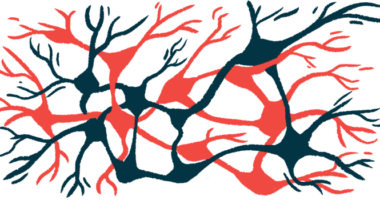Electroconductive Hydrogels Ease Parkinson’s Symptoms In Rat Model

Electroconductive hydrogels prevented the loss of dopamine-producing nerve cells (neurons) and motor function when injected into the brain, a study in a rat model of Parkinson’s disease showed.
The gels were also able to promote neuronal growth and prevent inflammation in cell cultures.
“Our work is the first to show the in-built therapeutic effect of an injectable, conductive self-healing hydrogel by the [Parkinson’s] animal model,” the researchers wrote, adding that these new hydrogels “may serve as a promising vehicle without additional cells or drugs for the treatment of [Parkinson’s].”
The study, “An anti-inflammatory electroconductive hydrogel with self-healing property for the treatment of Parkinson’s disease,” was published in the Chemical Engineering Journal.
Hydrogels are three-dimensional networks made of water and peptides that are tightly linked together. Formed naturally or synthetically, they resemble the flexibility of human tissue, and are thus of great interest for biomedical applications. The gels are often leveraged as carriers of therapeutic molecules into the body.
The composition of hydrogels influences their properties and biological effects. Electroconductive hydrogels contain molecules that conduct electricity, and are thought to have potential regenerative properties in tissues that are electrically active, such as the brain. Such hydrogels may be therapeutic on their own, even when not carrying other therapeutic substances.
A research team in China developed a new type of injectable electroconductive hydrogel. They found the gels had several promising properties, including an ability to self-heal, conduct electricity, and degrade naturally.
The team then evaluated whether their new and improved hydrogels might show therapeutic promise in Parkinson’s compared with control hydrogels, without needing to be loaded with additional therapeutic cargo.
Other hydrogel types have shown an ability to promote the growth of neural stem cells — nerve cell precursors — and stimulate their transition, or differentiation, towards mature nerve cells.
The researchers found that when neural stem cells derived from mice were encapsulated in the new hydrogels (called CDAH2), they grew by 650% over two weeks in cell cultures — significantly more than the 511% seen with the control hydrogels.
CDAH2 hydrogels were also more able to direct neural stem cell differentiation towards nerve cells, as reflected by increased gene activity associated with nerve cell maturation.
Evidence also suggested that CDAH2 gels were anti-inflammatory. Treatment with interferon-gamma, a pro-inflammatory molecule, led neural stem cells to show signs of inflammation and cell death. After encapsulating the cells with the nanoparticles for 12 hours, the ratio of unhealthy or dead cells declined significantly. Specifically, about 80% of unhealthy and inflamed cells transformed back to a healthy status in the presence of the hydrogel.
When mouse macrophages — a type of immune cell — were encapsulated in CDAH2 in cell cultures, inflammatory molecule levels were significantly lower and anti-inflammatory molecules significantly higher than in cells encapsulated in a control hydrogel.
The researchers injected either CDAH2, a control hydrogel, or saline directly into the brains of a rat model of Parkinson’s.
Similar to the effects observed in cell cultures, macrophages in the rats’ brains showed an anti-inflammatory shift two weeks after CDAH2 treatment, one that was significantly greater than that observed in rats receiving the control gel.
The cellular findings also translated into functional improvements in the rats. CDAH2-treated rats showed significant recovery of motor function after treatment, whereas those given the control gel did not improve.
Examining the rats’ brains showed that the electroconductive CDAH2 gel injection led to increased density of dopamine-producing nerve cells in the brain. These are the cells that are predominately lost in Parkinson’s. Signs of neuroinflammation also diminished.
The findings suggest the new electroconductive hydrogels have therapeutic properties that may be beneficial in Parkinson’s, the researchers said, noting that their hydrogels differ from previously reported ones because they are inherently therapeutic.
“These findings support conductive CDAH hydrogels as promising biomaterials for neuroprotection and [Parkinson’s] treatment,” the researchers concluded.







